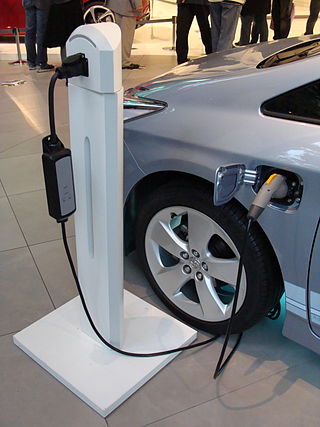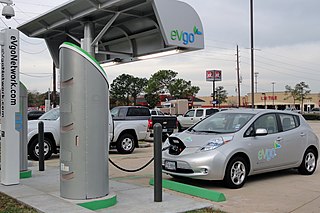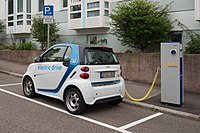Related Research Articles

The adoption of plug-in electric vehicles in the United States is supported by the American federal government, and several states and local governments. As of December 2021, cumulative sales in the U.S. totaled 2.32 million highway legal plug-in electric cars since 2010, led by all-electric cars. The American stock represented 20% of the global plug-in car fleet in use by the end of 2019, and the U.S. had the world's third largest stock of plug-in passenger cars after China (47%) and Europe (25%).

Electric car use by country varies worldwide, as the adoption of plug-in electric vehicles is affected by consumer demand, market prices, availability of charging infrastructure, and government policies, such as purchase incentives and long term regulatory signals.

Government incentives for plug-in electric vehicles have been established around the world to support policy-driven adoption of plug-in electric vehicles. These incentives mainly take the form of purchase rebates, tax exemptions and tax credits, and additional perks that range from access to bus lanes to waivers on fees. The amount of the financial incentives may depend on vehicle battery size or all-electric range. Often hybrid electric vehicles are included. Some countries extend the benefits to fuel cell vehicles, and electric vehicle conversions.

The adoption of plug-in electric vehicles in the Netherlands is actively supported by the Dutch government through the exemption of the registration fee and road taxes. These purchase incentives have been adjusted over time. Considering the potential of plug-in electric vehicles in the country due to its relative small size and geography, the Dutch government set a target of 15,000 to 20,000 electric vehicles with three or more wheels on the roads in 2015; 200,000 vehicles in 2020; and 1 million vehicles in 2025. The first two targets were achieved two years earlier than planned.

The adoption of plug-in electric vehicles in Germany is actively supported by the German Federal Government. Under its National Plattform for Electric Mobility, Chancellor Angela Merkel set an initial goal in 2010 to deploy one million electric vehicles on German roads by 2020, which was achieved with a six months delay in July 2021. Initially, the government did not provide subsidies to promote sales of plug-in electric vehicles, however, by the end of 2014 it was recognized that the country was well behind the set sales targets. A purchase bonus scheme was approved in 2016, but premium cars were not eligible to the incentive. In order to meet the climate targets for the transport sector, in 2016 the government set the goal to have from 7 to 10 million plug-in electric cars on the road by 2030, and 1 million charging points deployed by 2030.

As of September 2022, there were about 150,000 electric vehicles registered in Texas.
As of August 2022, there were about 96,000 electric vehicles in Florida. As of January 2022, 3.5% of all new vehicles sold in the state were electric.
As of October 2021, there were about 33,000 electric vehicles in Illinois.
As of June 2022, there were about 40,000 electric vehicles in Virginia, accounting for 0.5% of all vehicles in the state. As of August 2022, 2% of new vehicles sold in the state were electric.
As of April 2022, there were about 4,200 electric vehicles registered in New Mexico. As of 2021, 1.7% of new vehicles sold in the state were electric.
As of 2021, there were about 7,500 electric vehicles registered in Wisconsin.
As of 2022, there were about 80,000 electric vehicles in British Columbia. As of 2021, 13% of all new vehicles sold in the province were electric.
As of July 2022, there were about 5,000 electric vehicles registered in Alabama.
As of April 2022, there were about 3,700 electric vehicles registered in Kentucky.
As of June 2021, there were 3,410 electric vehicles registered in Oklahoma.
As of 2022, there were about 8,400 electric vehicles in Iowa, equivalent to 0.2% of all vehicles in the state.
As of January 2021, there were about 6,300 electric vehicles in South Carolina.
As of 2022, there were 780 electric vehicles registered in Mississippi, equivalent to 0.04% of all vehicles in the state.
As of September 2022, there were about 2,600 electric vehicles in Nebraska, equivalent to 0.2% of all vehicles in the state.
As of 2021, there were 2,942 electric vehicles registered in Singapore, equivalent to 0.46% of all vehicles in the country. As of May 2022, 8.4% of new cars registered in Singapore were electric.
References
- ↑ Cadigan, Jeena (June 22, 2021). "West Virginia is the 6th lowest state when it comes to electric vehicle sales". WBOY. Retrieved May 9, 2022.
- ↑ Voelcker, John (July 16, 2015). "State With Dirtiest Power Grid Had Highest Electric-Car Incentive, But Now Only For Natural-Gas, LPG Cars (UPDATED)". Green Car Reports. Retrieved May 29, 2022.
- ↑ Fouse, Macy (April 27, 2022). "West Virginia Electric Vehicle Incentives". getjerry.com. Retrieved May 29, 2022.
- ↑ Kane, Mark (June 25, 2017). "West Virginia: Adds $200 Annual Fee For Electric Vehicles, $100 For PHEVs". Inside EVs. Retrieved May 29, 2022.
- ↑ Kirk, Sam (May 12, 2022). "Are electric car charging stations accessible in West Virginia?". WBOY. Retrieved May 25, 2022.
- ↑ "Powering Transportation Through A West Virginia Fuel". TechConnect WV. Retrieved May 29, 2022.
- ↑ Fernatt, Robert (March 24, 2022). "Make WV wild, wonderful and electric (Opinion)". Charleston Gazette-Mail. Retrieved May 25, 2022.
- ↑ Cline, Hannah (August 4, 2022). "Electric vehicle charging stations to make their way to West Virginia". WCHS. Retrieved December 22, 2022.

